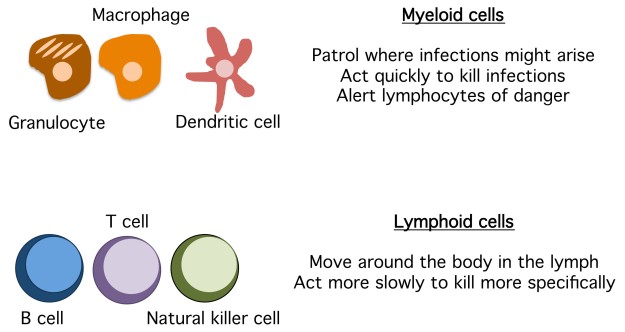The distinction between myeloid cells and lymphoid cells
We recently covered the fact that hematopoietic (blood) stem cells can make all the blood cell types in the body, including white blood (immune) cells. The immune cells are broadly broken down into two categories: myeloid and lymphoid.
Myeloid cells
Myeloid cells include neutrophils, macrophages, dendritic cells, mast cells, and granulocytes. These cells tend to be found in the tissues- your skin, organs, and other locations where an infection might rear its head. They have three main jobs.
- Pick up information from their environment, which will tell them if any threats are nearby.
- Kill infected cells and pathogens like bacteria.
- Communicate with other immune cells, including lymphoid cells, sounding the alert when danger is detected.
Myeloid cells are part of the innate immune system.
Lymphoid cells
Lymphoid cells, or lymphocytes, include T cells, B cells, and natural killer (NK) cells. As the name suggests, these cells are prominent in the lymph, a fluid that drains from the tissues containing cells and debris. These cells tend to have a large nucleus and few granules (the pockets that contain their ammunition). Lymphocytes mount a more sophisticated, targeted attack against threats than myeloid cells. B cells and T cells are part of the adaptive immune system, while NK cells are known to have properties of innate and adaptive immune cells.
We think about myeloid and lymphoid cells separately, since they are made and live in distinct areas in the body, plus they have different jobs. But as we continue, you’ll see how closely linked they must be to keep us healthy- no immune cell is an island.
Next time we’ll talk about the key differences between the innate and adaptive immune responses. As you may guess from the names, innate immunity uses techniques that cells are “born” with to fight infections. Adaptive immunity requires adaptation. For me, that’s where things start to get really interesting!
Drop me a line in the comments if you have thoughts about which type of cells, myeloid or lymphoid, would respond first if you cut your finger.
